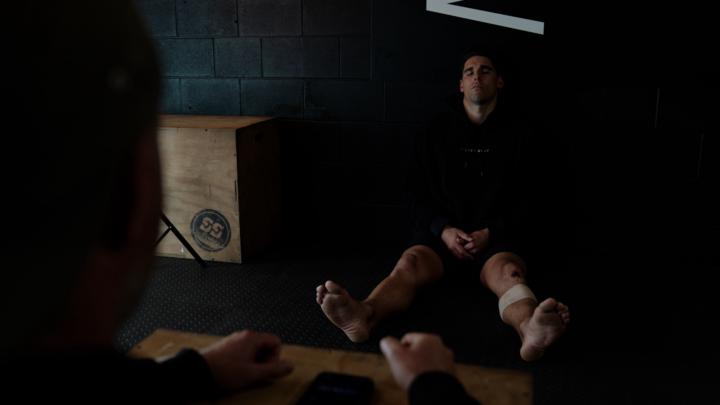Activity
Mon
Wed
Fri
Sun
Oct
Nov
Dec
Jan
Feb
Mar
Apr
May
Jun
Jul
Aug
Sep
What is this?
Less
More
Memberships
Integrated Training
382 members • Free
21 contributions to Integrated Training
Challenge for those finding it hard to get in a routine with the breath work.
If you can't get in a routine with the breathing training it's likely because you're trying to do too much on top of already being overloaded . If that sounds like you then this challenge is what you need as it simplifies the process and will help get you into a consistent routine that you can build on. You will be pleasantly surprised at the effect that as little as 10 minutes of breath work a day will have on your energy, focus, productivity, recovery and ability to shift into a calm state. Follow these guidelines 1. For the next 2 weeks you are going to do only 10 minutes of breath work a day. You can choose to do this in 1 setting OR beak it into 2 session of 5 minutes duration. 2. Use the exercise titled "create your own breathing flows" from the breathing for calm and focus section of the course. Try these Cadence Breathing examples - Using the Apnea Trainer app or any other breathing pacer. Find what works for you. You can combine multiple breathing cadences into a session or you can just focus on one particular breathing cadence that gets you relaxed. (4 inhale: 4 hold : 6 exhale : 4 hold) (6 : 4 : 8 : 4) (6 : 6 : 8 : 0) (5 : 5 : 7 : 0) (6 : 0 : 8 : 0) (5 : 0 : 7 : 0) (7 : 4 : 8 : 4) (8 : 10 : 12 : 0) (8 : 10 : 12 : 4) (8 : 8 : 10 : 0) (8 : 8 : 10 : 4) 3. Don't overthink it, just find the cadence or cadences that work to get you most relaxed and create a 10 minute breathing flow that you do daily - stick to it and share your results on the performance Breathing discussion page. Once you have completed the 2 weeks then go back through the course again and simplify the process - you don't have to do everything and you don't have to commit hours a day to it. Find what works for YOU! Cheers

Report after 630 minutes of 21 Minute breathing flow
30 days - 630 minutes of practice, executed in 32 days. I wanted to do it 30 days consecutively but there were 2 days I was too relaxed I suppose I didn't even think about it. - Disclaimer; ramble. - What are some of the things I learned? Along with other practices like my Zazen practice ( Sitting meditation ), Actively looking into myself through various means ( Relationships, paying attention to my own perceptions around anything), paying attention to my diet, sleep, hydration, substances like weed and alcohol ( The quitting of abusing these mostly ) I learned a deep level of self-acceptance, self-reverence, or self-love, It doesn't really matter what words I use but essentially what it comes down to is that I really learned to fully accept myself in the moment of the 21 minute practice, in whatever state I was in, what ever I had done that day. This is monumental for a guy that used to train over 25 hours a week and still had the idea that he wasn't doing enough. Gradually, with effort and work I was able ( And still am ) carrying this state of acceptance with me where-ever I went, taking the practice on the road if you will. - The second thing the practice taught me is to clear my lens of what I thought my energy levels were, and what I thought how much my training impacted my energy levels in terms of energy gained and ''lost'' - Again, monumental, I was able to train way more effective, with more substance, and most of all get super consistent and able to pay more attention to my body, the signs of pain or discomfort and trace back the origins of those things. Happy I started doing this in the winter time, where naturally there is less Energy ( I've seen the Sun maybe 2-3 times in December in the Netherlands ) so I didn't try to force to override the fact that there's simply less energy available. The clarity on energy levels I feel is so fundamental to be able to create balance in your life when it comes to Yin (Yielding) and Yang (Expressing) energies, Energy making and Energy taking.
Delaying onset and duration of lactic acid build up
Hey Team, I understand that building your c02 tolerance will help improve the delay the onset and duration of lactic acid build up. How exactly does this work in the body? When and why does the body start producing Lactic Acid and how does having a better oxygen transfusion come into play? I know it has something to do with the kidneys, bicarbonate, but I forget the specifics and would like to be reminded, thank you in advance. Chaim
Do the breathing muscles "steal blood flow from the legs" when they fatigue
Respiratory Metaboreflex refers to a physiological mechanism that helps regulate blood flow and breathing during exercise. Simply put, Respiratory Metaboreflex is where the body restricts blood flow to the limbs (in particular the legs) when the breathing muscles fatigue. The body will do this to ensure the role of breathing continues. This is because breathing is crucial to survival. Therefore, when the body experiences a conflict between breathing and moving, breathing wins out. Respiratory Metaboreflex involves a feedback loop where the metabolic demands of active muscles affect the respiratory and cardiovascular systems. The metabolic costs of supporting respiratory muscle function during maximal exercise requires up to 16 % of the bodies total cardiac output - this is a huge percentage of overall cardiac output. The body works hard to ensure that blood flow and oxygen delivery to the respiratory muscles are prioritised during high intensity work loads as a means of survival. I am going to give a simplified explanation of Respiratory Muscle Metaboreflex. 1. During high intensity work (Anaerobic training) the respiratory muscles have to work hard to maintain adequate oxygenation and Carbon dioxide removal. As high intensity work is sustained the breathing muscles experience a build up of metabolites (such as lactic acid). Think high intensity work and heavy/fast breathing - imagine peddling on a stationary bike and going as hard as you can without stopping and the associated fast, deep and heavy breathing that would be required to maintain such output. 2. As the metabolites in the respiratory muscle (diaphragm, intercostal muscles) accumulate, sensory receptors in those muscles send signals to the brain to activate the sympathetic nervous system (stress response). 3. The increase in Sympathetic nervous system activity results in an increase in heart rate (pump more blood and oxygen around the body to meet the higher energy demands of body tissue) and an increase in blood pressure (to help maintain cardiac output). As part of this sympathetic response, blood flow to the limbs is redirected to the breathing muscles. This occurs secondary to limb vasoconstriction (blood vessels constrict reducing blood flow to the legs). This in turn redistributes blood flow to the breathing muscles + lungs (see attached images)
WHY TRAIN THE RESPIRATORY 🫁 SYSTEM?
Many people/athletes think that if they’re already fit and functioning at a high level, why would they need to train their respiratory system (lungs, diaphragm, and respiratory muscles). The human body is an integration of body systems (11 body systems in total) that work in synergy to maintain optimal functioning. When we exercise, we put extra demands on our muscular, cardiovascular, nervous, and respiratory systems. A shortfall in one system has a knock-on effect through each and every other system. For example; over breathing during exercise will elevate heart rate and put the cardiovascular system under more load. It is not uncommon for very fit athletes that I train to have relatively poor breathing mechanics, lack of awareness of breathing rate control and both over breath during light-medium intensity exercise and under breath during high intensity exercise.The thing about the human body is that it is the master of compensation and while the body adapts to dysfunction and imbalance in the respiratory system it results in inefficient training, prolonged recovery, increase risk of injury and impacts there ability to sustain peak performance over the long term. Each bodily system also relies on the constant uptake and utilisation of oxygen, so the respiratory system can be viewed as the most fundamentally important body system. It doesn’t matter how much time, energy and focus you put into cardio (cardiovascular system) and conditioning (muscular system), unless you have good breathing capacity then you won’t achieve peak performance. Often, we gas out NOT because of a lack of cardiovascular or muscular endurance but because of inadequate breathing capacity. What is the one thing you focus on when you’re exhausted or under the pump? It’s your breathing, every time. Yet we rarely specifically train the respiratory system in order to improve its function, like we would cardio, for example. This course is designed to improve your OVERALL breathing capacity and bring more awareness to how you breath and how to use this body system to improve focus, energy control, recovery, endurance, power and self awareness.

0 likes • Dec '24
It really do be like that. An interesting phenomenon that often also occurs with athletes or just people training is that "their legs go from underneath them" I've learned a cause of this can be from the diaphragm "stealing" blood from the legs to keep functioning - in the end, your breath is more important to survival than your legs are. Another vocal point we can take to investigate our respiratory system and the symptoms there of when it is not functioning optimally. Cheers Dave! Chaim
1-10 of 21
@chaim-ariel-2339
Learn - Educate - Embody - Share
Have been passionate about health since age 16 and looking to make my career out of it in the next 5-10 years.
Active 23d ago
Joined Nov 15, 2024
Powered by


